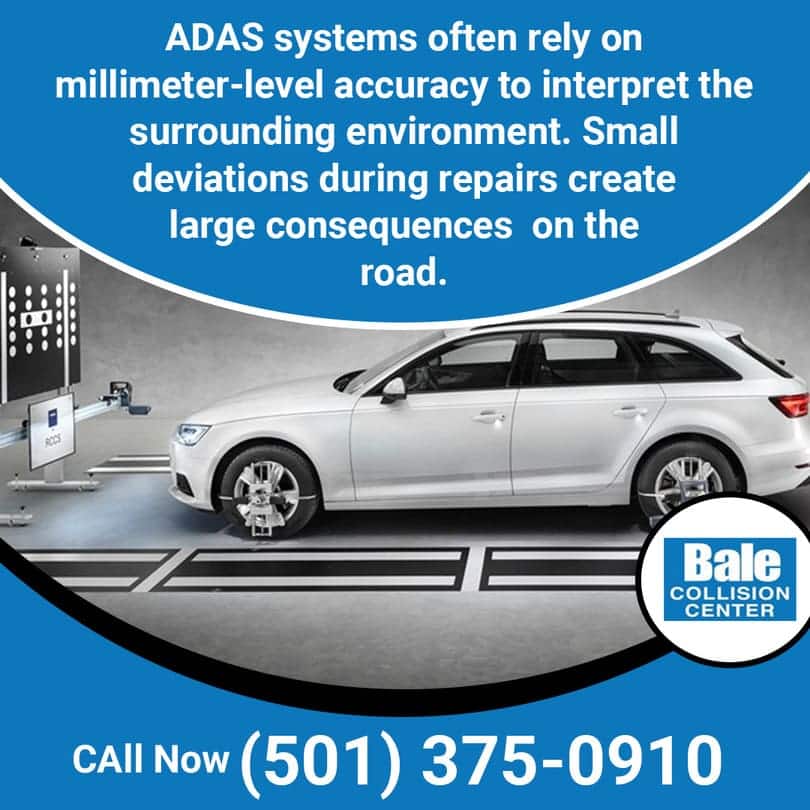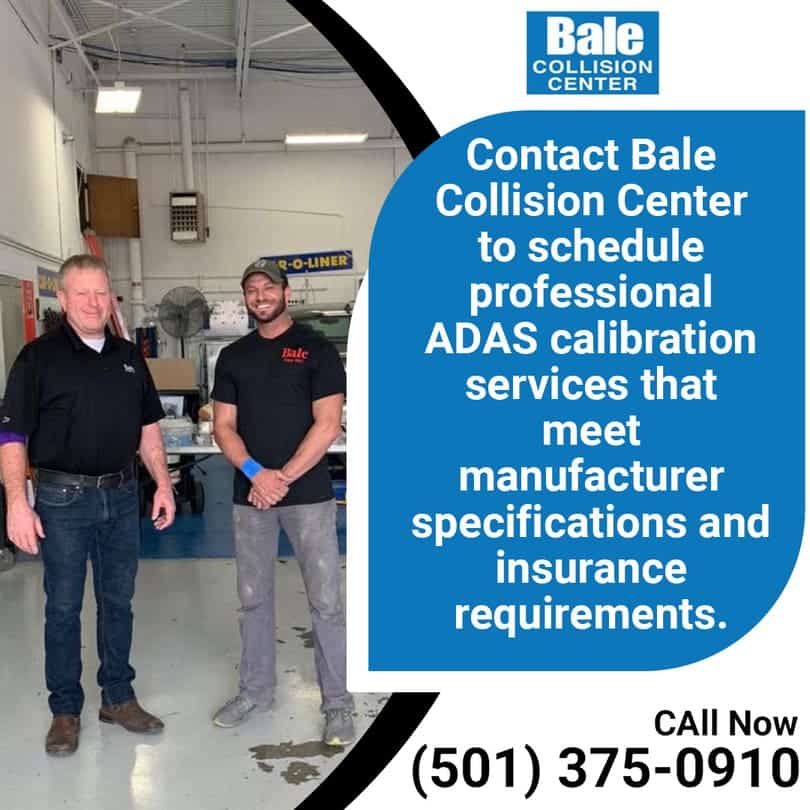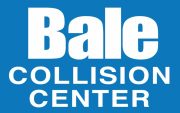Modern vehicles depend on Advanced Driver Assistance Systems (ADAS) to protect drivers and passengers on the road. These sophisticated safety features use cameras, sensors, and radar to detect potential hazards and prevent crashes. However, after any vehicle collision repair work, these systems require precise recalibration to function properly. Driving before ADAS features are fully recalibrated creates serious safety risks that many vehicle owners don’t realize.
At Bale Collision Center (Downtown), we have provided trusted auto collision repair services to Little Rock families since 1952. Our technicians understand that modern collision repair extends far beyond fixing dented panels and scratched paint. Today’s vehicles require specialized knowledge of safety systems and precise ADAS calibration using manufacturer-approved equipment. By being aware of the risks associated with miscalibrated safety systems, you can make sure your vehicle’s advanced features work as intended.

Understanding ADAS and Its Critical Role in Vehicle Safety
Advanced Driver Assistance Systems (ADAS) use a network of cameras, sensors, radar, and advanced algorithms to continuously monitor your vehicle’s surroundings and assist drivers in preventing accidents.
What ADAS Technology Includes
ADAS consists of a wide range of safety features that work together to protect drivers, passengers, and pedestrians. Common ADAS features include automatic emergency braking, which can detect possible crashes and apply the brakes when drivers can’t react quickly enough. Lane departure warning systems monitor road markings and notify drivers when they start to drift out of their lane unintentionally. Blind spot monitoring uses sensors to detect vehicles in areas that mirrors can’t cover, while adaptive cruise control maintains safe following distances by automatically adjusting vehicle speed.
Forward collision warning systems look for obstacles on the road ahead and provide alerts when collision risk increases. Cross-traffic alert helps drivers backing out of parking spaces by detecting approaching vehicles or pedestrians. These features represent just a part of the ADAS technologies available in today’s vehicles, with new capabilities being added regularly as technology advances.
The Safety Impact of ADAS Technology
The statistics on ADAS effectiveness are remarkable. According to the National Highway Traffic Safety Administration (NHTSA), its final rule requiring automatic emergency braking (AEB) on all new light vehicles is expected to prevent about 362 deaths and reduce injuries by more than 24,000 each year. AAA Foundation studies project that ADAS technologies could help avoid nearly 250,000 fatalities and 14 million nonfatal injuries over the next 30 years.
At our Downtown Little Rock auto collision center, we see firsthand how ADAS technology has changed collision repair. Modern repair process now requires understanding not just traditional bodywork, but also the complex electronics and calibration procedures that keep these life-saving systems functioning properly.
Why ADAS Calibration Is Necessary After Any Vehicle Collision Repair
Auto collision repair work can affect ADAS sensor alignment, making recalibration necessary for safe operation. ADAS components are positioned with millimeter-level precision throughout your vehicle. Something as routine as bumper repair or windshield replacement can shift these critical sensors out of their factory specifications.
Sensor Sensitivity to Impact
Even minor collisions can knock out ADAS sensors. Front and rear radar sensors are often located behind bumper covers and are particularly vulnerable during repair procedures. Side-impact collisions can affect blind spot monitoring sensors, while any impact affecting the windshield area can misalign forward-facing cameras that power multiple safety features.
Effects of Common Collision Repair Work
Many standard repair procedures can impact ADAS function. Windshield replacement often requires recalibration because forward-facing cameras mount behind the glass. Body panel repairs can shift sensor mounting points. Even wheel alignment work changes vehicle ride height, altering how cameras and sensors view the road environment.
At our Downtown Little Rock auto collision center, we’ve seen vehicles where minor fender repairs affected multiple safety systems because sensors share mounting points with seemingly unrelated components.
Manufacturer Requirements Vary by Vehicle
Vehicle manufacturers specify different calibration requirements for different types of collision repair work. Some require recalibration after any structural work, while others mandate it following specific component replacements. Following these OEM procedures helps maintain your vehicle’s warranty and safety performance after insurance-approved collision repair services.
The Dangers of Driving With Uncalibrated ADAS Systems
Driving with uncalibrated ADAS systems after collision repair creates serious safety risks that aren’t immediately apparent but can have dangerous consequences. These sophisticated safety features work continuously behind the scenes to monitor your vehicle’s surroundings and assist with driving tasks.
False Safety Warnings Create Driver Distraction
Misaligned systems may trigger warnings when there’s no actual danger, causing driver distraction and stress. Lane departure warnings might activate incorrectly, or blind spot monitors could give false alerts about vehicles that aren’t there. This constant stream of incorrect warnings can lead drivers to ignore or disable safety features entirely, leaving themselves vulnerable to real hazards.
Missed Critical Warnings Put Lives at Risk
Improperly calibrated systems might fail to alert you to genuine hazards when you need protection most. A forward collision warning system with an improperly calibrated camera might not detect a stopped vehicle ahead, failing to provide the warning that could prevent a crash. This defeats the purpose of having ADAS technology in the first place.
Compromised Emergency Braking Systems
Automatic emergency braking systems rely on precise sensor data to determine when intervention is necessary. A misaligned radar sensor after vehicle collision repair might not accurately measure the distance to vehicles ahead. This could prevent the system from braking when needed or cause it to brake unnecessarily, creating rear-end collision risks.
IIHS research, as summarized by Collision Repair Magazine, found that a 1-degree misalignment in a windshield‑mounted ADAS camera can impair both automatic emergency braking response and lane‑departure warning accuracy.
Lane-Keeping Problems After Collision Repair
Lane departure warning and lane-keeping assistance systems depend on cameras that recognize road markings. If these cameras are misaligned after windshield replacement or front-end collision repair work, they might not accurately track lane position. This can cause the system to provide incorrect steering input or fail to warn when you’re drifting out of your lane.
Adaptive Cruise Control Malfunctions
Adaptive cruise control systems use radar to maintain safe following distances. When radar sensors are misaligned during repair procedures, they provide inaccurate distance measurements. This might result in following too closely, braking unnecessarily, or failing to adjust speed appropriately in traffic situations.
The Insurance and Liability Implications
Driving with uncalibrated ADAS systems after vehicle collision repair can create liability issues for both vehicle owners and repair shops. Insurance companies increasingly recognize the importance of proper ADAS calibration and may question claims if safety systems weren’t properly restored after repairs.
Insurance Coverage Expectations
Most insurance companies now include ADAS calibration costs in their repair estimates because they understand the safety implications. When these calibrations are skipped or done incorrectly during repair work, it can affect future claims if the vehicle is involved in another accident.
Legal Liability Concerns
If an uncalibrated ADAS system fails to prevent an accident that it should have prevented, questions arise about who is responsible. Repair shops that don’t properly calibrate ADAS systems after repair work may face liability for resulting accidents.
Warranty Considerations
Vehicle manufacturers require ADAS calibration after certain repairs to maintain warranty coverage. Skipping this step during vehicle collision repair can void warranties on safety systems and other vehicle components.
At Bale Collision Center, we work with all major insurance companies and understand their requirements for ADAS calibration. Our approach to vehicle collision repair includes proper safety system restoration to protect our customers from liability issues.

Bale Collision Center: Expert ADAS Services in Little Rock
Bale Collision Center has provided trusted vehicle collision repair services in Little Rock since 1952. Our experience, combined with modern technology and continuing education, makes us the right choice for ADAS calibration and auto collision repair services.
Certified Expertise and Advanced Equipment
Our I-CAR Platinum-certified technicians receive ongoing training in the latest ADAS technologies and calibration procedures. We use manufacturer-approved diagnostic and calibration equipment to ensure your safety systems meet original factory specifications after any collision repair work.
Comprehensive Insurance-Approved Services
We work with all major insurance companies and understand their requirements for ADAS calibration services. Our experience with insurance-approved collision repair helps streamline the repair process and provide proper coverage for necessary calibration work at our Downtown Little Rock auto collision center.
Complete Safety System Restoration
Our services include everything from initial damage assessment through final ADAS calibration and verification. We handle the complete repair process, including coordination with insurance companies, to minimize inconvenience while ensuring your vehicle’s safety systems function properly.
Protecting Your Family’s Safety Through Proper Calibration
ADAS systems represent a significant advancement in vehicle safety technology, but they only provide protection when properly calibrated and maintained. Understanding the risks of driving with uncalibrated systems helps you make informed decisions about collision repair and ongoing vehicle maintenance.
The statistics speak clearly about the safety benefits of properly functioning ADAS. However, these benefits depend entirely on proper system calibration after any auto collision repair work. Don’t compromise your family’s safety by driving with uncalibrated ADAS systems after collision repairs. The temporary inconvenience of proper calibration is minimal compared to the potential consequences of system failure when you need protection most.
Schedule Your ADAS Calibration Today
If your vehicle has been in a collision or undergone repairs that might affect ADAS systems, don’t wait to have them properly calibrated. The safety of you and your family depends on these systems working correctly when you need them most.
At Bale Collision Center, we provide expert insurance-approved collision repair and ADAS calibration services that meet manufacturer specifications and insurance requirements. Our experienced technicians at our Downtown Little Rock auto collision center use the latest diagnostic equipment to make sure your safety systems function properly after any collision repair work.
Call (501) 375-0910 or email bccdowntown@baleautomotive.com to schedule your ADAS calibration or repair estimate. Technicians at our Downtown Little Rock auto collision center are ready to restore your vehicle’s safety systems and get you back on the road with confidence.
Trust Bale Collision Center for thorough collision repair services that prioritize your safety and peace of mind. We are generations of families, helping generations of families do life safely on Arkansas roads.
